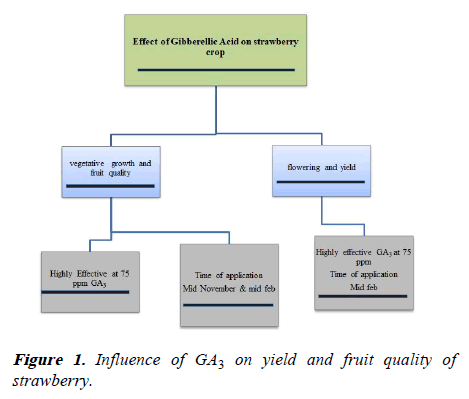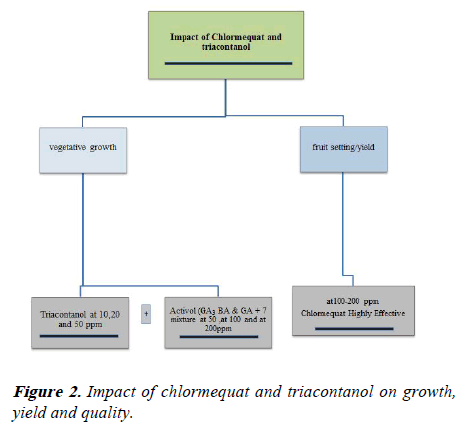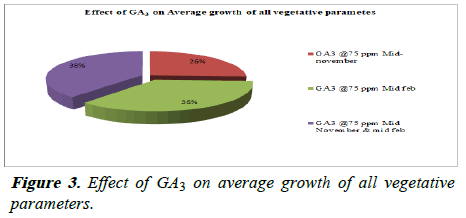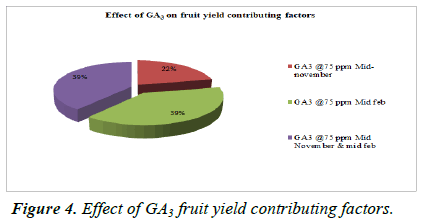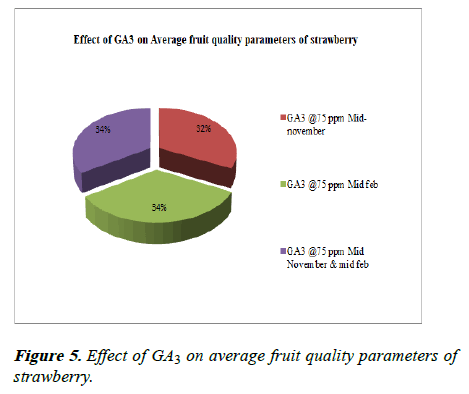Research Article - Journal of Biochemistry and Biotechnology (2023) Volume 6, Issue 6
Plant growth regulators and their effect on growth, development and yield of strawberry (Fragaria x ananassa Duch.).
Lakhwinder Singh, Ramesh Kumar Sadawarti*
Department of Horticulture, Lovely Professional University, Punjab, India
- Corresponding Author:
- Ramesh Kumar Sadawarti
Department of Horticulture,
Lovely Professional University,
Punjab,
India
E-mail: lakhwindersingh60478@gmail.com
Received: 25-May-2023, Manuscript No. AABB-23-100063; Editor assigned: 29-May-2023, AABB-23-100063 (PQ); Reviewed: 13-June-2023, QC No. AABB-23-100063; Revised: 24-Jul-2023, Manuscript No. AABB-23-100063 (R); Published: 31-Jul-2023, DOI:10.35841/aabb.6.6.171
Citation: Singh L, Sadawarti RK. Plant growth regulators and their effect on growth, development and yield of strawberry (Fragaria x ananassa Duch.). J Biochem Biotech. 2023;6(6):1-6.
Abstract
Strawberry is one of the important cash crop grown throughout the globe and liked in various form such as extracts, fresh fruits etc. It is an octaploid species (2n=8x=56) belonging to genus Fragaria of family Rosaceae is one of most delicious and nutritious among soft fruits of the world. Strawberry is the unique fruit with having excellent source of all vitamins, flavour, and highly desirable taste, sugars, fibres and potassium. PGR’s (Plant Growth Regulators) are the organic substances which are produced naturally; they control the growth of the plant and other physiological functions in the plants. Besides this, expression of intrinsic genetic capability also manage by PGRs. Expression of genes has been control by the use of PGRs at both transcriptional and translational level. This paper reviews the effect of different plant growth regulators on plant’s growth, development, yield and quality of fruits. PGRs are operative to increase the vegetative growth, flowering and yield of fruits per plant in temperate, tropical and subtropical regions. Most of all studies revealed that higher concentration level of Gibbereliic Acid (GA3) enhances the vegetative growth of the plant and also the production of runners in strawberry plants although cycocel, which is a growth retardant influence the quality of fruit.
Keywords
Strawberry, Plant growth regulators, GA3, Cycocel, Subtropical regions
Introduction
Strawberry fruits are highly rich with significant minerals and vitamins. Plants of strawberry can grow 20-25 cm (8-10 inch) in height with economic life of 2-4 years before the plants are replaced. Strawberry plants may also be planted as garden strawberry and the plants are grown in northern temperate regions of the world. The first domestic hybrids were created in the Europe. The pH range of soil is about 4.6-6.5 for the production of strawberry. In India, total area under strawberry cultivation is 1 lakh hectare [1]. There annual production is nearly about 8 million tonnes (NHB 2019-2020) in 2nd advance estimate. In the comparison of other fragile berry fruits, strawberry fruits are having higher content of vitamin C, flavonoids and phenolics. According to data related to Food and Agriculture Organization of the United Nations (FAOSTAT) it confirms China is the absolute leader by all means in production of strawberry with probably 3,336,690 tons during year 2020 and USA with 1,055,963 tons of strawberry production. In India, strawberry is cultivated in Maharashtra, West Bengal, Himachal Pradesh, Uttrakhand, Uttar Pradesh, Delhi, Haryana, Punjab and Rajasthan. The fruit colour of strawberry is red and fleshy in nature with small seeds on the outside of the fruit. Plants of strawberry can grow 20-25 cm (8-10 inch) in height with economic life of 2-4 years before the plants are replaced. Strawberry plants may also be planted as garden strawberry and the plants are grown in northern temperate regions of the world. The first domestic hybrids were created in the Europe. The pH range of soil is about 4.6-6.5 for the production of strawberry. In India, approximately 1 lakh hectare total area under strawberry cultivation. Production of crop is near about 8 million tonnes (NHB 2019-2020) in 2nd advance estimate. Some of countries like Bangladesh, Germany, Austria, Jordan are major exporting countries to which strawberry is exported [2].
Morphologically, strawberry plant has a compressed thick and vertical stem known as crown. It produces rosette of leaves and inflorescence in spring. The leaves are pinnately compound and trifoliate with leaflets varying in shape from wedge to ovate. During the growing season, the auxiliary buds of crown produces prostrate growth called runners. Numerous daughter plants arise from nodes. When the base of these new leaves come into contact with moist soil, adventitious roots are emerged [3]. The inflorescence arranged in the form of cyme. The flower of activated type is perfect although dioecious species also occurs. Flower contains five sepals and equal number of petals, flowers in warm season and requires short photoperiod followed by chilling of crown during winter to stimulate spring vegetative growth [4].
Materials and Methods
With the application of plant growth regulators we can increase the production of fruits per plant as well as the quality of fruit crop. With regarding to height of plant gibberellic acid plays significant role, GA3 also improve the number of runners per plant, number of flowers/plant, number of fruits/plant, fruit set ratio/plant, size of fruit, weight of fruit and quality of fruits. Chlorocholine Chloride (CCC) is gibberellins biosynthesis inhibitor which is responsible for cyclization of gerenylgeranyl pyrophosphate to the copyallyl pyrophosphate [5]. Highly mobile in xylem and phloem tissue is chlormequat chloride which is rapidly absorbed and translated. Chlormequat chloride which is also water soluble and absorbed by all tissues of the plant, it is effective when applied as drench or spray method. The production of poor quality fruits is a matter of common experience. It would be therefore worthwhile to improve the yield and quality of fruit crops by foliar application of plant growth regulators. The use of plant growth regulators has assumed a basic part for increasing the production of fruits in modern crop husbandry. Plant growth regulators are the important organic compounds, which used to regulate and to modify physiological processes in an appreciable measure in the plants when used in balanced concentrations. PGRs move rapidly and are readily absorbed through the tissue, when they are applied to different parts of plant. Plant growth regulators are the chemicals which are specific in their action. In other words, PGRs are type of organic substances (different from nutrients), which when applied to plants even in small amount promote, inhibit or modify the physiological processes in fruit crops. Thereby, plant growth regulators are used for resulting outstanding outcomes in different fruit crops with respect to crop’s growth, quality and yield [6]. So by the application of PGRs we can control the plant growth to make a plant more effective with respect to growth parameters, quality parameters and yield components which are commercially more acceptable for marketing. In this review article the effect of several PGRs on strawberry plant‘s growth, development and yield has been studied. Though work on this fecet is very limited, it has been tried to compile it in comprehensive way in this article [7].
Effect of gibberellic on strawberry
Fruits of strawberry are metabolically very active and perform as sinks for nutrients with the hormones which regulate the process. Amongst the different PGRs, gibberellins which is a plant growth promoter control the development of fruit and growth of the plant in several manners at various stages of development. Development of fruit is not easy to analyse or firmly modulated process, so development of fruits can be segregated into stages that involve pre-pollination, pollination, fertilization, setting of fruit, fruit ripening and senescence [8].
Impact on vegetative growth and runners production
Camacaro, et al., observed that with the application of GA3, plants showed good blooming and also growth, they observe that the plants treated with GA shows maximum number of leaves and plant height. In 2012 Eshghi studied that GA3 did not increased weight of fruit and production of fruits, but At 100 ppm of GA3 decreased the Inflorescence and higher runners per plant noticed. Elshabsi, et al., noticed that the plants treated with 100 ppm of GA3, increased the production of flowers. Singh and Sharma revealed that 75 ppm of GA3 in chandler variety of strawberry influence the pattern of growth and decreased the weight of fruit [9]. Paroussi registered that GA increased the flower bud in different three varieties of strawberry (Laguna, Seascape and Camarosa). The plants which are treated with the GA3 higher number of runners per plant registered. Plants treated with 50 ppm GA3, In that plants highest number of runners was reported [10]. Luangprrasert showed that with the application of GA3 at 4 leave stage Tioga species, production of runners was increased with on harmful effect on number of branches, number of leaves and branch crown production. Due to application of GA3 growth of shoots by stimulating cell division rapidly and promote the plant shoots as well as stem. In their study they also observed that with the higher amount of GA3 production of fruits decline. In 1992 Cutting, et al., studied the effect of GA3 in strawberry crop they observed that with balanced application of GA3 in strawberry, It promotes the vegetative growth of shoot apex of plants and has crucial role in morphogenesis which helps to plant for growth of new leaves and rapidly growth of plant [11]. Brian due to the increased length of internodes which were in the stage of elongation at the treatment time, the shoot length is increased by the application of GA3. Porohit, et al., observed that increase of growth by GA3 regards to utilization of starch, due to enhanced mobilization by GA3, higher amount of food materials are there over a period, results a spurt in the growth. Starch accumulates extremely early in the fruit formation process and that starch degradation predominates during plant growth and development. Bennet et al., observed that application of GA3 at 50 ppm on one year old plant in July month restrict flowering but promote the runner development in the plants [12]. Leaf number was also increased with increasing the concentration of gibberellic acid. This might be attributed to the fact that GA3 supply induces cell elongation and cell division. Spray of GA3 after 8 weeks of planting decreases the number of inflorescence in the plants. In 1964 Thompson and Guttridge revealed that the plants treated with GA3 shows increased runner’s growth and growth of plant. Foliar application of gibberellic acid at 50, 200 mg/l had increased petiole length and leaf area of the strawberry plants. Kumar, et al., observed the plant’s which were treated with at 75 ppm of gibberellic acid effectively increase all the vegetative parameters viz., height of plant, length of plant, total number of leaves per plant, plant spreading and also leaf area index of the plant [13]. As GA3, increases the vegetative parameters of plants it can be substitute as growth promoting substance for plants.
Influence of GA3 in flowering of plant
Parousi, et al., observed that GA3 was effective on flowering of the plants, It increases the number of flowers. Cathey, et al., reported that GA3 significant effect on Inflorescence and flowering production of plants. Sharma, et al., observed that when GA3 applied in higher concentration [14]. It tooks minimum days to flowering. Adam, et al., revealed that GA3 is effective for both cell enlargement and division of cells in the plants. Cell division and cell enlargement has significant role to successful fertilization of the ovule. Gibberellin have striking growth promoting effects, speed up the elongation of the plants and promote the flowering in plants. In 2016 Sajid, et al., observed that with the application of GA3, plants were able to initiate early flowering by inhibits the function of abscisic acid which helps to enhancing uptake of nutrients, balancing C/N ratio in leaves, filling of carbohydrates in sinks, and by activate the activity of hydrolysing enzymes. Ali, et al., recorded that total yield was negatively affected due to higher concentration of GA3 (200 mg/l) [15].
Results and Discussion
Influence of GA3 on yield and fruit quality of strawberry
Lovatt observed that GA3 at 60 ppm to full bloom stage, at 75 ppm at petal fall stage and at 25 ppm in early july, increase the yield of plants as compare with the untreated plants. Moneruzaman, et al., reported that GA3 treated plants, shows higher fruit length and diameter as compare to untreated plants. Sharma, et al., found that when GA3 applied at 80 ppm in plants, shows higher vegetative growth of the plants, ascorbic acid content, runner production, and acidity [16]. GA3 at 75 ppm provide maximum total number of fruits in strawberry. Ingle et al., reported that GA3, when applied by foliar method at 25 ppm in the plants, Increase the weight of fruit, ascorbic acid content, TSS, peel and yield as compare with the control. Sharma, et al., studied that with the application of GA3 at 50 ppm, shows partially deblossoming but quality of fruits was improved in the subtropical region. Singh reported the influence of GA3 at 75 ppm, with FYM 50 t/ha supplemented with the superphosphate, he observed that weight of fruits and size of fruits was increase with maturing, fruit TSS and acidity content was also improved. Application of GA3 at 50-200 ppm increase the fruit weight and and bunch but decrease the TSS content in the fruits and also delay the ripening of the fruits [17]. Davis, et al., find out that the plants treated with GA3, increase the cell size or cell numbers. Dwivedi, et al., reported the influence of GA3 at 50 ppm, he noted maximum leaf numbers and maximum leaf area was observed which improve the yield of crop per plant. In Tioga maximum leaf area and leaf number was observed with application of GA3. Wang et al., was also reported maximum number of leaves per plant with the application of GA3 at 200 ppm. Cheikh and Brenner, et al., observed that GA3 control the development of fruits in different ways and at various stages of development. Development of fruits is a tightly regulated and complex process. Metabolically fruits which are in growing stage are very active and required strong nutrients along with hormones for modulating their further development stage. Development of fruits have its various phases that include pre pollination, pollination then fertilization and fruit setting after that various stages of fruits like post fruit set, ripening process and senescence. After division of cells and expansion of cells, fertilization of ovule is successfully done. GA3 effect both cell division as well as enlargement of cells [18]. Regarding the impact of foliar application of gibberellic acid on total yield and its components and fruit quality, Rasheed indicated that strawberry plants, treated with GA3 at 150 mg/l gave the longest fruits, while concentration of at 300 mg/l gave the highest yield per plant. Similar results were found by Uddin, et al., who showed that GA3 at 75 ppm gave the best growth and yield of strawberry plants (Figure 1 and Table 1) [19].
| Effect of GA3 (PGR’s) | Concentration | Plant response |
|---|---|---|
| GA3 | 75 ppm | Maximum number of leaves and plant height. |
| GA3 | 100 ppm | Decreased the Inflorescence and higher runners per plant noticed. |
| GA3 | 100 ppm | Increased the production of flowers. |
| GA3 | At 150 mg/l | Gave the longest fruits. |
| GA3 | At 300 mg/l | Gave the highest yield per plant. |
| GA3 | 75 ppm | Influence the pattern of growth and decreased the weight of fruit. |
| GA3 | 50 ppm | Restrict flowering but promote the runner development, leaf number was also increased. |
| GA3 | 200 mg/l | Total yield was effected, the runner development. |
| GA3 | At 80 ppm | Shows higher vegetative growth of the plants, ascorbic acid content, runner production. |
| GA3 | At 300 mg/l | Gave the highest yield per plant. |
| GA3 | 75 ppm | Gave the best growth and yield of strawberry plants. |
Table 1. Effect of GA3 on different growth parameters of strawberry crop.
Impact of chlormequat and triacontanol on growth, yield and quality
Growth retardants in plants significantly used to modify the vegetative growth of fruit plants, to increase the total number of flowers per plant and to maximize the no. of fruits/plant or fruit setting/yield. It is recorded that application of PGRs indirectly effect on flowering by restricting vegetatative growth of the plant. Will, et al., observed in their three years of study that application of cycocel in the month of September in plants gave early flowering and slightly high yield. In 1975 Barritt reported that application of 100-200 ppm CCC on gorilla variety of strawberry in the first week of march enhance the flower opening and increase fruit setting in plants. Thakur observed that triacontanol at 10, 20 and 50 ppm, activol (GA3 BA and GA+7 mixture at 50, at 100 and at 200 ppm) and at 5, 10 and 25 ppm of NAA, observations were made on flowering and growth parametres. Early flowering and maximum number of fruits per plant observed. Benoit observed that plants which were treated with CCC (Cycocel) showed positively increased fruit yield. Results shows that triacontanol was more effective in case of strawberry crop for plant’s vegetative growth and chlormequat at various concentrations showed good results in strawberry crop. Will, et al., observed in their three years of study that application of cycocel in the month of September in plants gave early flowering and slightly high yield. In 1975 Barritt reported that application of 100-200 ppm CCC on gorilla variety of strawberry in the first week of march enhance the flower opening and increase fruit setting in plants (Figure 2 and Table 2) [20].
| Chlormequat and triacontanol (PGR’s) | Concentration | Plant response |
|---|---|---|
| Cycocel (CCC) | - | Early flowering and slightly high yield. |
| Cycocel | 100-200 ppm | Enhance the flower opening and increase fruit setting in plants. |
| Triacontanol | At 10, 20 and 50 ppm, Activol (GA3 BA and GA+7 mixture at 50, at 100 and at 200 ppm) | Early flowering and maximum number of fruits per plant observed, promote the runner development. |
| CCC | 100-200 ppm | First week of march enhance the flower opening and increase fruit setting in plants. |
Table 2. Effect of chlormequat and triacontanol on different growth and yield parameters of strawberry crop.
Impact of triacontanol and NAA on growth, yield and quality
A natural plant growth regulator (Triacontanol) found in epicuticular waxes. It is used to increase the fruit production. Quite a number of researchers have concluded that TRIA mediated improvement in growth, yield, photosynthesis activity, synthesis of protein, water uptake capacity, nutrients uptake capacity, activities of enzymes, free amino acid content, total reducing sugar and soluble protein. Expectedly, TRIA enhances the physiological efficiency of the cells and thus, exploits the genetic potential of plant to a large extent.
Hormones which are endogenous and their balance effect the mobilization of nutrients to the developing organs and promote the longevity of buds. The dependence of abscission relative to the endogenous content material of auxins has been demonstrated by means of exogeneous utility of 2,4-D or NAA, as the transportation of auxins with the aid of the plant lasts for a long time without ethylene appearing to affect it.
Chibnal, et al., Vlitos reported that triacontanol, a natural component enhance vegetative growth, chlorophyll content and yield when applied in field condition. Application of NAA, triacontanol and activol showed maximum vegetative growth as compared with the untreated plants. Maximum height of crown (7.2 cm) was recorded with at 100 ppm of activol and maximum leaf numbers per plant (7) and maximum leaf area (49.4 m2) were recorded in plants which were treated with at 50 ppm of tricontanol. Kumar observed that maximum yield per plant Cv. Tioga which were treated with tricontanol at 5 ppm before flowering emergence. Tiwari, et al., studied that application of tricontanol, increased height of plants, plant spreading, number of leaves, weight of fruit (g). The diameter of fruit, volume, acidity %, and total sugars: Acid ratio was recorded with plants which were treated with at 400 ppm in strawberry plants. NAA is an artificial auxin plant hormone this is used for the vegetative propagation of plants life from stem and cutting. The impact of NAA on growth of plant is greatly dependent on the time of admission and concentration. NAA has been proven to significantly increase cellulose fiber formation. In majority of fruit crops, fruit drop is controlled via spraying of NAA in exclusive fruit plants in exclusive concentration. It is carried out after blossom fertilization in plants (Figures 3-5 and Tables 3-5).
| PGRs | Time of application | Petiole length (cm) | Crown height (cm) | Crown spread (cm) | Leaf number | Leaf area (cm2) | Flower intiation (DAP) | No. of flowers | Fruit setting (%) |
|---|---|---|---|---|---|---|---|---|---|
| GA3 at 75 ppm | Mid-november | 6.7 | 16.5 | 18.2 | 16.2 | 24.3 | 82.5 | 39.8 | 26.3 |
| GA3 at 75 ppm | Mid feb | 5.2 | 14.3 | 15.6 | 12.4 | 28.5 | 103.4 | 63.6 | 79.1 |
| GA3 at 75 ppm | Mid November and mid feb | 7.2 | 18.5 | 21.4 | 17.8 | 31.6 | 104.4 | 64.6 | 81.4 |
Table 3. Effect of GA3 on vegetative parameter of strawberry.
| PGRs | Time of application | Total fruit yield (g/plant) | Fruit weight (g) | Marketable yield (g/plant) |
|---|---|---|---|---|
| GA3 at 75 ppm | Mid-November | 294.6 | 11.2 | 11.2 |
| GA3 at 75 ppm | Mid Feb | 529.2 | 10.5 | 10.5 |
| GA3 at 75 ppm | Mid November and mid Feb | 526 | 10 | 10 |
Table 4. Effect of GA3 on fruit yield contributing factors of strawberry.
| PGRs | Time of application | Juice (%) | TSS (%) | Acidity (%) | Ascorbic acid (mg/100 g pulp) |
|---|---|---|---|---|---|
| GA3 at 75 ppm | Mid-November | 73.4 | 6.86 | 0.72 | 45.9 |
| GA3 at 75 ppm | Mid Feb | 74.2 | 7.14 | 0.88 | 49.7 |
| GA3 at 75 ppm | Mid November and mid Feb | 74.8 | 7.2 | 0.82 | 50.4 |
Table 5. Effect of GA3 on fruit quality parameters of strawberry.
Conclusion
From the above stuidies, it can be concluded that application of gibberllic substitute for growth promotion, to initiate early flowering by inhibiting the abscisic acid functioning and successful fertilization of the ovule is followed by cell division and cell expansion resulting in the growth of the fruit in strawberry plants. Triacontanol enhances the physiological efficiency of the cells in the plants. NAA has been shown to greatly increase cellulose fiber formation in plants. Whereas, plant growth retardant Cycocel (CCC) improve the quality and yield of fruits of in strawberry plants.
References
- Arnon DI. Copper enzymes in isolated chloroplasts. Polyphenoloxidase in Be vulgaris. Plant physiol. 1949;24(1):1.
[Crossref] [Google Scholar] [PubMed]
- Ahmed ME, El-Latif, Al-Ballat IA, et al. Effect to gibberellic acid concentrations and runners'removal rates on yield and quality of frigo strawberry plantations. Menoufia J Plant Prod. 2017;2(5):395-406.
- Asrey R, Jain RK, Singh R. Effect of pre-harvest chemical treatments on shelf life of chandler strawberry (Fragaria x ananassa). Indian. J Agric Sci. 2004.
- Barritt BH. The effect of gibberellic acid, blossom removal and planting date on strawberry runner plant production. HortSci. 1994;9:25-7.
- Davies PJ. The plant hormones: Their nature, occurrence, and functions. 3rd Edition. Springer. Netherlands. 2010:1-15.
- Chibnall AC, Williams EF, Latner AL, et al. The isolation of ntriacontanol from lucerne wax. Biochem J. 1993;27(6):1885.
[Crossref] [Google Scholar] [PubMed]
- Hazarika TK, Ralte Z, Nautiyal BP, et al. Influence of bio-fertilizers and bio regulators on growth, yield and quality of strawberry (Fragaria × ananassa). Indian J Agric Sci. 2015;85(9):1201-5.
- Kumar S, Kaur G. Effect of pre harvest application of salicylic acid on plant growth parameters and yield of strawberry cv. Chandler. J Pharmacogn Phytochem. 2019:85-7.
- Klaas L, Kahu K, Libek AV, et al. Effects of foliar applied fertilizers and removal of runners on the yield and berry quality of strawberry cultivar ‘Polka’ on black plastic mulch. Hortic. 2009;28(4).
- El-Shabasi MSS, Ragab ME, El-Oksh II, et al. Response of strawberry plants to some growth regulators. Acta Hortic. 2008;842:725-8.
- Guttridge CG, Thompson PA. The effect of gibberellins on growth and flowering of Fragaria and Duchesnea. J Exp Bot. 1964;15(3):631-46.
- Jamal Uddin AFM, Hossan MJ, Islam MS, et al. Strawberry growth and yield responses to gibberellic acid concentrations. J Exp Biol. 2012;3(2):51-56.
- Kumar R, Bakshi M, Singh DB. Influence of plant growth regulators on growth, yield and quality of strawberrry (Fragaria x ananassa Duch.) under UP sub tropics. Asian J Hortic. 2012;7:434-6.
- Kumar R, Saravanan S, Parshant B, et al. Influence of gibberellic acid and blossom removal on fruit quality of strawberry (Fragaria × ananassa Duch.) cv. belrubi. Vegetos. 2013;26:107-10.
- Luangprasert N. Effect of gibberellic acid on growth and fruit production of tioga strawberry grown in winter on highland of phetchaboon province. Agric Nat Resour. 1994;28(1):22-6.
- Moneruzzaman KM, Hossain ABMS, Normaniza O, et al. Growth, yield and quality responses to Gibberellic Acid (GA3) of wax apple Syzygium samarangense var. Jambu air madu fruits grown under field conditions. Afr J Biotechnol. 2011;10(56):11911-8.
- Nanda KK, Purohit AN. Effect of gibberellin on mobilization of reserve food and its correlation with extension growth. Planta. 1965;66:121-5.
- Perkins-Veazie P. Growth and ripening of strawberry fruit. Hortic Rev. 1995;17:267-97.
- Paroussi G, Voyiatzis DG, Paroussis E, et al. Growth, flowering and yield responses to GA3 of strawberry grown under different environmental conditions. Sci Hortic. 2002;96(1):103-13.
- Ries SK, Stutte CA. Regulation of plant growth with triacontanol. Crit Rev Plant Sci. 1985;2(3):239-85.
